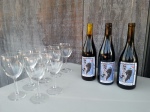In March 2015, the Alcohol and Tobacco Tax and Trade Bureau (TTB) approved the use of powdered alcohol in the United States. It appears it will eventually become available in both consumable and non-ingestible industrial forms, but when and where it will be available for purchase is yet unknown. The General Foods Corporation made powdered alcohol as early as the 1970’s by absorbing ethyl alcohol/ethanol into a carbohydrate powder. Many patents exist on the product, but powdered alcohol is still not readily available and some believe that is a good thing.
Turning water into alcohol drinks by just adding powder has generated fear of abuse. Some parents and legislators believe the ease of concealment of powdered alcohol would encourage use among underage drinkers. In spite of liquid alcohol being readily available, some legislators are considering banning the sale of the powdered form. Some states have already banned sale of the product.
Mark Phillips with Lipsmark have recently obtained the TTB’s approval, but authorities are not clear on how to tax the product. Labels have been approved and it appears it will be available soon. Lipsmark, LLC, located in Tempe, AZ, produces six varieties of palcohol including vodka, rum, and four cocktails.
Lipsmark’s products so far include:
“R”- rum, made from cane sugar
“V”- vodka, made from grain
Cosmopolitan cocktail
Mojito
Lemon Drop
Powderita, a margarita-like drink
The Lipsmark website states the reactive legislation is based on misinformation regarding misuse and abuse. Inappropriate use, including snorting the powder is one concern but the company reports it would be difficult to snort, and a very ineffective way to feel alcohol effects. It would take a long time to sniff the equivalent of one shot of vodka up your nose. The powder on mucus membranes generates the harsh burn of alcohol.
In Japan, a powdered product producing a 12% alcohol brandy-like drink is made by Sato Industries. The company released this alcohol drink in 1981. In Germany, a powdered alcohol product sells for about $3 US dollars per drink. The Netherlands also sells a product called Booz2Go.
There are a variety of potential beneficial uses for non-ingestible forms, including: military and industrial applications, medicinal topical use, and a fuel source. Other benefits of the powdered product include its light weight and potential use by back-packers, and for consumption on weight-limited airliners.
The ease of carrying the powder into public events, plus the possibility of covertly spiking the drinks of unsuspecting individuals, generated enough concern for Maryland legislators that they quickly banned the sale of powdered alcohol. Alaska, Delaware, Louisiana, South Carolina and Vermont followed suit.
Failures of Prohibition have not deterred more legislators from considering a ban that could move Palcohol to the black markets. Taxing and controlling its sale would stop that trend. Mark Phillips emphasizes the decisions to ban are based on ignorant speculation. He reminds people of the failure of Prohibition.
We remind people to always drink sensibly and drive sober.
For additional information directly from Phillips’ site consult: http://www.palcohol.com. For additional information from a legal source consult: http://www.bevlaw.com
Betty and Bev


